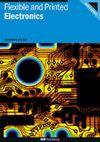Novel approach to utilise highly conductive but electrochemically unstable current collector materials in textile supercapacitor electrodes
IF 3.2
4区 工程技术
Q3 MATERIALS SCIENCE, MULTIDISCIPLINARY
引用次数: 1
Abstract
Metal-based materials, such as silver or copper, are highly desired as current collector materials for flexible energy storage due to their excellent electrical properties but lack the long-term operational electrochemical stability. Herein we report a method to prevent the corrosion of such materials, while fully exploiting their electrical properties. This was achieved by covering the current collector with an electrochemically stable conductive carbon-based layer. The barrier layer allows the flow of charge between the electrically conductive elements of the textile composite electrodes, while protecting the current collector from contacting the electrolyte. The areal power and energy densities obtained after 1000 bending cycles were 29.88 and 0.01 mWh cm−2, respectively, with no evident degradation. Additionally, patterned current collectors were designed to deposit lower quantities of ink, without detriment to electrochemical performance. After 1000 bending cycles, the textile composite supercapacitors (TCSs) having 50% less current collector material demonstrated an areal power and energy density of 28.08 and 0.01 mWh cm−2, respectively. The proposed strategy is essential in enabling the utilisation of highly conductive metal-based inks, improving the rate capabilities and long-term operation of wearable energy storage devices, while maximising specific power and energy densities of TCSs, and decreasing the manufacturing cost.在纺织超级电容器电极中利用高导电但电化学不稳定的集流体材料的新方法
金属基材料,如银或铜,由于其优异的电学性能,但缺乏长期操作的电化学稳定性,因此非常需要作为柔性储能的集流材料。在此,我们报告了一种方法,以防止这些材料的腐蚀,同时充分利用其电性能。这是通过在电流收集器上覆盖一层电化学稳定的导电碳基层来实现的。阻挡层允许电荷在纺织复合电极的导电元件之间流动,同时保护电流收集器不与电解质接触。1000次弯曲循环后得到的面功率和能量密度分别为29.88和0.01 mWh cm−2,没有明显的退化。此外,图案集流器被设计成沉积较少数量的油墨,而不会损害电化学性能。经过1000次弯曲循环后,具有较少50%集流材料的纺织复合材料超级电容器(TCSs)的面功率和能量密度分别为28.08和0.01 mWh cm - 2。所提出的策略对于实现高导电性金属基油墨的利用,提高可穿戴储能设备的速率能力和长期运行,同时最大化TCSs的比功率和能量密度,并降低制造成本至关重要。
本文章由计算机程序翻译,如有差异,请以英文原文为准。
求助全文
约1分钟内获得全文
求助全文
来源期刊

Flexible and Printed Electronics
MATERIALS SCIENCE, MULTIDISCIPLINARY-
CiteScore
4.80
自引率
9.70%
发文量
101
期刊介绍:
Flexible and Printed Electronics is a multidisciplinary journal publishing cutting edge research articles on electronics that can be either flexible, plastic, stretchable, conformable or printed. Research related to electronic materials, manufacturing techniques, components or systems which meets any one (or more) of the above criteria is suitable for publication in the journal. Subjects included in the journal range from flexible materials and printing techniques, design or modelling of electrical systems and components, advanced fabrication methods and bioelectronics, to the properties of devices and end user applications.
 求助内容:
求助内容: 应助结果提醒方式:
应助结果提醒方式:


